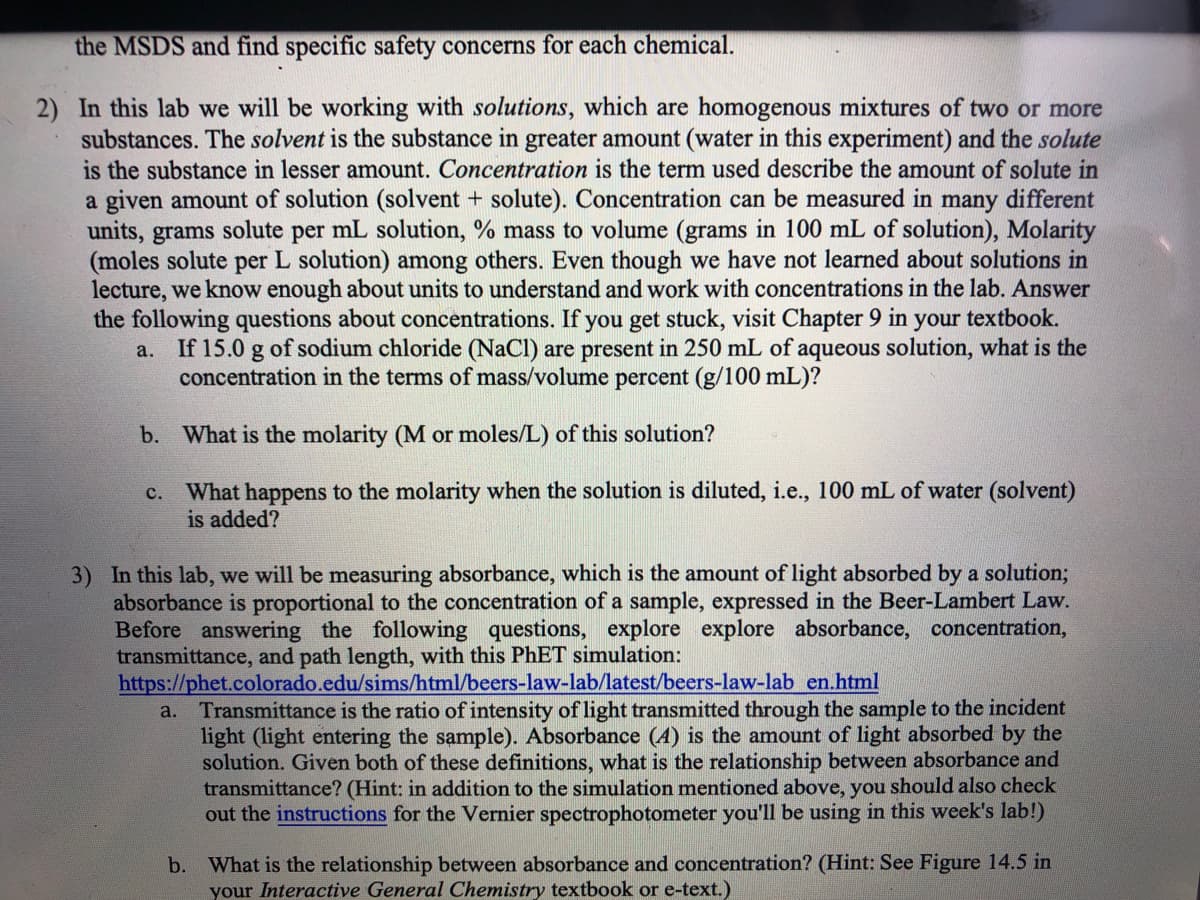2) In this lab we will be working with solutions, which are homogenous mixtures of two or more substances. The solvent is the substance in greater amount (water in this experiment) and the solute is the substance in lesser amount. Concentration is the term used describe the amount of solute in a given amount of solution (solvent + solute). Concentration can be measured in many different units, grams solute per mL solution, % mass to volume (grams in 100 mL of solution), Molarity (moles solute per L solution) among others. Even though we have not learned about solutions in lecture, we know enough about units to understand and work with concentrations in the lab. Answer the following questions about concentrations. If you get stuck, visit Chapter 9 in a. If 15.0 g of sodium chloride (NaCl) are present in 250 mL of aqueous solution, what is the your textbook. concentration in the terms of mass/volume percent (g/100 mL)? b. What is the molarity (M or moles/L) of this solution? c. What happens to the molarity when the solution is diluted, i.e., 100 mL of water (solvent) is added?
2) In this lab we will be working with solutions, which are homogenous mixtures of two or more substances. The solvent is the substance in greater amount (water in this experiment) and the solute is the substance in lesser amount. Concentration is the term used describe the amount of solute in a given amount of solution (solvent + solute). Concentration can be measured in many different units, grams solute per mL solution, % mass to volume (grams in 100 mL of solution), Molarity (moles solute per L solution) among others. Even though we have not learned about solutions in lecture, we know enough about units to understand and work with concentrations in the lab. Answer the following questions about concentrations. If you get stuck, visit Chapter 9 in a. If 15.0 g of sodium chloride (NaCl) are present in 250 mL of aqueous solution, what is the your textbook. concentration in the terms of mass/volume percent (g/100 mL)? b. What is the molarity (M or moles/L) of this solution? c. What happens to the molarity when the solution is diluted, i.e., 100 mL of water (solvent) is added?
Chapter88: Column Chromatography
Section: Chapter Questions
Problem 5P
Related questions
Question
Only number 2. It has parts a , b, c

Transcribed Image Text:the MSDS and find specific safety concerns for each chemical.
2) In this lab we will be working with solutions, which are homogenous mixtures of two or more
substances. The solvent is the substance in greater amount (water in this experiment) and the solute
is the substance in lesser amount. Concentration is the term used describe the amount of solute in
a given amount of solution (solvent + solute). Concentration can be measured in many different
units, grams solute per mL solution, % mass to volume (grams in 100 mL of solution), Molarity
(moles solute per L solution) among others. Even though we have not learned about solutions in
lecture, we know enough about units to understand and work with concentrations in the lab. Answer
the following questions about concentrations. If you get stuck, visit Chapter 9 in your textbook.
a. If 15.0 g of sodium chloride (NaCl) are present in 250 mL of aqueous solution, what is the
concentration in the terms of mass/volume percent (g/100 mL)?
b. What is the molarity (M or moles/L) of this solution?
What happens to the molarity when the solution is diluted, i.e., 100 mL of water (solvent)
is added?
с.
3) In this lab, we will be measuring absorbance, which is the amount of light absorbed by a solution3;
absorbance is proportional to the concentration of a sample, expressed in the Beer-Lambert Law.
Before answering the following questions, explore explore absorbance, concentration,
transmittance, and path length, with this PHET simulation:
https://phet.colorado.edu/sims/html/beers-law-lab/latest/beers-law-lab en.html
a. Transmittance is the ratio of intensity of light transmitted through the sample to the incident
light (light entering the sample). Absorbance (4) is the amount of light absorbed by the
solution. Given both of these definitions, what is the relationship between absorbance and
transmittance? (Hint: in addition to the simulation mentioned above, you should also check
out the instructions for the Vernier spectrophotometer you'll be using in this week's lab!)
b. What is the relationship between absorbance and concentration? (Hint: See Figure 14.5 in
your Interactive General Chemistry textbook or e-text.)
Expert Solution
This question has been solved!
Explore an expertly crafted, step-by-step solution for a thorough understanding of key concepts.
This is a popular solution!
Trending now
This is a popular solution!
Step by step
Solved in 3 steps

Recommended textbooks for you

EBK A SMALL SCALE APPROACH TO ORGANIC L
Chemistry
ISBN:
9781305446021
Author:
Lampman
Publisher:
CENGAGE LEARNING - CONSIGNMENT

EBK A SMALL SCALE APPROACH TO ORGANIC L
Chemistry
ISBN:
9781305446021
Author:
Lampman
Publisher:
CENGAGE LEARNING - CONSIGNMENT